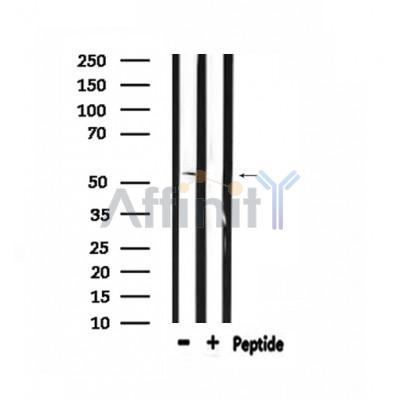5HT2B Receptor Antibody - #DF3500
| Product: | 5HT2B Receptor Antibody |
| Catalog: | DF3500 |
| Description: | Rabbit polyclonal antibody to 5HT2B Receptor |
| Application: | WB IHC IF/ICC |
| Cited expt.: | WB |
| Reactivity: | Human, Mouse |
| Prediction: | Horse, Chicken |
| Mol.Wt.: | 54 KD; 54kD(Calculated). |
| Uniprot: | P41595 |
| RRID: | AB_2835862 |
Related Downloads
Protocols
Product Info
*The optimal dilutions should be determined by the end user.
*Tips:
WB: For western blot detection of denatured protein samples. IHC: For immunohistochemical detection of paraffin sections (IHC-p) or frozen sections (IHC-f) of tissue samples. IF/ICC: For immunofluorescence detection of cell samples. ELISA(peptide): For ELISA detection of antigenic peptide.
Cite Format: Affinity Biosciences Cat# DF3500, RRID:AB_2835862.
Fold/Unfold
5 HT 2B; 5 HT 2B receptor; 5 HT(2B); 5 HT2B; 5 hydroxytryptamine (serotonin) receptor 2B; 5 hydroxytryptamine (serotonin) receptor 2B G protein coupled; 5 hydroxytryptamine 2B receptor; 5 hydroxytryptamine receptor 2B; 5-HT-2B; 5-HT2B; 5-hydroxytryptamine receptor 2B; 5HT(2B); 5HT2B_HUMAN; 5HT2F; Htr 2b; Htr2b; NP75 protein; SEROTONIN 5HT2B RECEPTOR; Serotonin receptor 2B; Stomach fundus serotonin receptor;
Immunogens
A synthesized peptide derived from human 5HT2B Receptor, corresponding to a region within the internal amino acids.
Ubiquitous. Detected in liver, kidney, heart, pulmonary artery, and intestine. Detected at lower levels in blood, placenta and brain, especially in cerebellum, occipital cortex and frontal cortex.
- P41595 5HT2B_HUMAN:
- Protein BLAST With
- NCBI/
- ExPASy/
- Uniprot
MALSYRVSELQSTIPEHILQSTFVHVISSNWSGLQTESIPEEMKQIVEEQGNKLHWAALLILMVIIPTIGGNTLVILAVSLEKKLQYATNYFLMSLAVADLLVGLFVMPIALLTIMFEAMWPLPLVLCPAWLFLDVLFSTASIMHLCAISVDRYIAIKKPIQANQYNSRATAFIKITVVWLISIGIAIPVPIKGIETDVDNPNNITCVLTKERFGDFMLFGSLAAFFTPLAIMIVTYFLTIHALQKKAYLVKNKPPQRLTWLTVSTVFQRDETPCSSPEKVAMLDGSRKDKALPNSGDETLMRRTSTIGKKSVQTISNEQRASKVLGIVFFLFLLMWCPFFITNITLVLCDSCNQTTLQMLLEIFVWIGYVSSGVNPLVYTLFNKTFRDAFGRYITCNYRATKSVKTLRKRSSKIYFRNPMAENSKFFKKHGIRNGINPAMYQSPMRLRSSTIQSSSIILLDTLLLTENEGDKTEEQVSYV
Predictions
Score>80(red) has high confidence and is suggested to be used for WB detection. *The prediction model is mainly based on the alignment of immunogen sequences, the results are for reference only, not as the basis of quality assurance.
High(score>80) Medium(80>score>50) Low(score<50) No confidence
Research Backgrounds
G-protein coupled receptor for 5-hydroxytryptamine (serotonin). Also functions as a receptor for various ergot alkaloid derivatives and psychoactive substances. Ligand binding causes a conformation change that triggers signaling via guanine nucleotide-binding proteins (G proteins) and modulates the activity of down-stream effectors. Beta-arrestin family members inhibit signaling via G proteins and mediate activation of alternative signaling pathways. Signaling activates a phosphatidylinositol-calcium second messenger system that modulates the activity of phosphatidylinositol 3-kinase and down-stream signaling cascades and promotes the release of Ca(2+) ions from intracellular stores. Plays a role in the regulation of dopamine and 5-hydroxytryptamine release, 5-hydroxytryptamine uptake and in the regulation of extracellular dopamine and 5-hydroxytryptamine levels, and thereby affects neural activity. May play a role in the perception of pain (By similarity). Plays a role in the regulation of behavior, including impulsive behavior. Required for normal proliferation of embryonic cardiac myocytes and normal heart development. Protects cardiomyocytes against apoptosis. Plays a role in the adaptation of pulmonary arteries to chronic hypoxia. Plays a role in vasoconstriction. Required for normal osteoblast function and proliferation, and for maintaining normal bone density. Required for normal proliferation of the interstitial cells of Cajal in the intestine (By similarity).
Cell membrane>Multi-pass membrane protein. Cell junction>Synapse>Synaptosome.
Ubiquitous. Detected in liver, kidney, heart, pulmonary artery, and intestine. Detected at lower levels in blood, placenta and brain, especially in cerebellum, occipital cortex and frontal cortex.
Ligands are bound in a hydrophobic pocket formed by the transmembrane helices.
Belongs to the G-protein coupled receptor 1 family.
Research Fields
· Cellular Processes > Cellular community - eukaryotes > Gap junction. (View pathway)
· Environmental Information Processing > Signal transduction > Calcium signaling pathway. (View pathway)
· Environmental Information Processing > Signaling molecules and interaction > Neuroactive ligand-receptor interaction.
· Organismal Systems > Nervous system > Serotonergic synapse.
· Organismal Systems > Sensory system > Inflammatory mediator regulation of TRP channels. (View pathway)
References
Application: WB Species: Mouse Sample:
Restrictive clause
Affinity Biosciences tests all products strictly. Citations are provided as a resource for additional applications that have not been validated by Affinity Biosciences. Please choose the appropriate format for each application and consult Materials and Methods sections for additional details about the use of any product in these publications.
For Research Use Only.
Not for use in diagnostic or therapeutic procedures. Not for resale. Not for distribution without written consent. Affinity Biosciences will not be held responsible for patent infringement or other violations that may occur with the use of our products. Affinity Biosciences, Affinity Biosciences Logo and all other trademarks are the property of Affinity Biosciences LTD.



